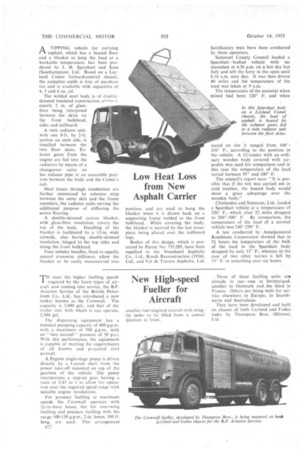Low Heat Loss from New Asphalt Carrier
Page 56

If you've noticed an error in this article please click here to report it so we can fix it.
ATIPPING vehicle for carrying asphalt, which has a heated floor and a blanket to keep the load at a -workable temperature, has been produced by J. H. Sparshatt and Sons (Southampton), Ltd. Based on a Leyland Comet forward-control chassis, the complete outfit is free of purchase tax and is available with capacities of 4, 5 and 6 cu. yd.
The welded steel body is of doubleskinned insulated construction, arr±ro-imately 2 in. of glassfibre being interposed between the skins on the front bulkhead, sides and tailboard.
A twin radiator unit, with one 8-ft. by 2-ft. section on each side, is installed between the two floor skins. Exhaust gases from the engine are fed into the radiators by means of a changeover valve on the exhaust pipe in an accessible position between the body and the Comet's cab.
Heat losses through conduction are further minimized by asbestos strip between the outer skin and the frame members, the radiator units serving the additional purpose of stiffening the entire flooring.
A double-skinned canvas blanket, with glass-fibre insulation, covers the top of the body. Handling of the blanket is facilitated by a 12-in, wide catwalk, also having double-skinned insulation,hinged to the top sides and along the front bulkhead.
Four tubular handles, fixed to equally spaced crosswise stiffeners, allow the blanket to be easily manoeuvred into position, and are used to hang the blanket when it is drawn back on a supporting frame welded to the front bulkhead. While covering the body, the blanket is secured by the last crosspiece being placed over the tailboard lugs.
Bodies of this design, which is protected by Patent No. 735,205, have been supplied to the Neuchatel Asphalte Co., Ltd., Roads Reconstruction (1934), Ltd.. and Val de Travers Asphalte, Ltd. Satisfactory tests have been conducted by three operators. • Somerset County Council loaded a Sparshatt bodied vehicle with tar macadam at 4.30 p.m. on a hot day last July and left the lorry in the open until 6.10 a.m. next day. It was then driven 40 miles and the temperature of the load was taken at 9 a.m.
The temperature of the material when mixed had been 120° F. and when
tested on site it ranged from 100'110' F., according to the position in the vehicle. A 12-tonner with an ordinary wooden body covered with tarpaulin was used for comparison and in this case the temperature of the load varied between 95° and 100° F.
The council's report says: " It is possible that if the test was carried out in cold weather, the heated body would. show a great advantage over the wooden body."
Chittenden and Simmons, Ltd., loaded a Sparshatt vehicle at a temperature of 320' F., which after 32 miles dropped to 260'-300° F. By comparison, the temperature of the load of a normal vehicle was 240%290° F.
A test conducted by Amalgamated Roadstone Corporation showed that in 5i hours the temperature of the bulk of the load in the Sparshatt body dropped by only 15° F., whereas in the case of two other lorrie& it fell by 35' F. in something over six hours.




















































































































